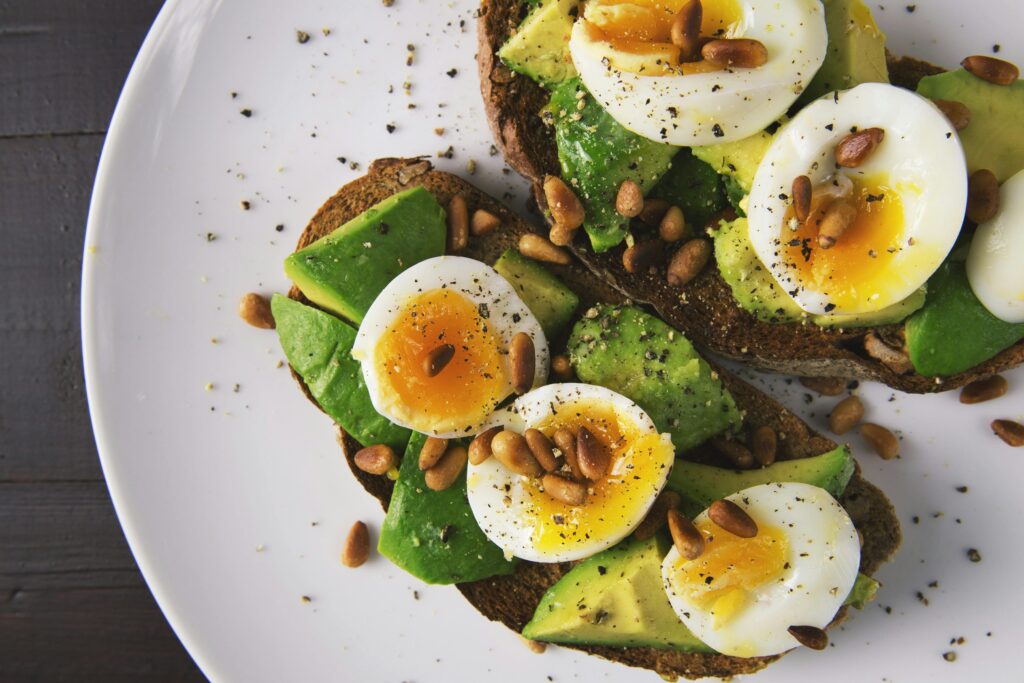What Is the Ketogenic Diet?
The ketogenic diet is a high-fat, very-low-carbohydrate eating plan designed to induce ketosis, where the body burns fat for energy instead of carbs. Originally developed for epilepsy treatment, it has gained popularity as a weight loss strategy, but its long-term effectiveness and safety are subjects of ongoing research.

Keto Basics
The ketogenic diet is a low-carb, high-fat diet, similar to the Atkins and low-carb diets. It involves a drastic reduction in carbohydrate intake and replacing it with fats. This shift puts the body into a state of ketosis, where it efficiently burns fat for energy and produces ketones in the liver.
Types of Keto Diets
There are several versions of the ketogenic diet, each with its own rules:
- Standard Ketogenic Diet (SKD): This is a very low carb, moderate protein, high-fat diet, typically with 70% fat, 20% protein, and 10% carbs.
- Cyclical Ketogenic Diet (CKD): Involves cycles of higher carb refeeds, like 5 ketogenic days followed by 2 high-carb days.
- Targeted Ketogenic Diet (TKD): Allows carb intake around workouts.
- High Protein Ketogenic Diet: Similar to the standard version but includes more protein, often with a ratio of 60% fat, 35% protein, and 5% carbs. Note that SKD and High Protein Ketogenic Diet are the most studied.
Achieving Ketosis
Ketosis is the metabolic state where the body uses fat for fuel instead of carbs. To achieve ketosis, one must significantly reduce carb intake to around 20-50 grams per day and focus on fats from sources like meat, fish, eggs, nuts, and healthy oils. Moderating protein intake is crucial to prevent conversion into glucose.
Testing Ketosis
Various tests, such as blood, urine, and breath tests, can measure ketones to determine if the body has entered ketosis. Symptoms like increased thirst, dry mouth, frequent urination, and decreased appetite may also indicate ketosis.
Weight Loss on Keto
The ketogenic diet is effective for weight loss, with some studies showing it to be as effective as low-fat diets. It promotes weight loss without the need for calorie counting. Research indicates reductions in diastolic blood pressure and triglyceride levels.
Keto and Diabetes
The keto diet can be beneficial for those with diabetes, improving insulin sensitivity and reducing hemoglobin A1C levels. Studies show weight loss and enhanced blood sugar management in individuals with type 2 diabetes.
Other Health Benefits
Originally developed for epilepsy treatment, the keto diet is being explored for various health conditions, including heart disease, cancer, Alzheimer’s, epilepsy, Parkinson’s, polycystic ovary syndrome, and brain injuries. However, research in these areas is ongoing.
But benefits also include potential weight loss, reduced hunger, improved blood sugar control, and lower triglycerides.

Foods to Avoid and Consume
AVOID
- sugary foods: soda, fruit juice, smoothies, cake, ice cream, candy, etc.
- grains or starches: wheat-based products, rice, pasta, cereal, etc.
- fruit: all fruit, except small portions of berries like strawberries
- beans or legumes: peas, kidney beans, lentils, chickpeas, etc.
- root vegetables and tubers: potatoes, sweet potatoes, carrots, parsnips, etc.
- low fat or diet products: low fat mayonnaise, salad dressings, and condiments
- some condiments or sauces: barbecue sauce, honey mustard, teriyaki sauce, ketchup, etc.
- unhealthy fats: processed vegetable oils, mayonnaise, etc.
- alcohol: beer, wine, liquor, mixed drinks
- sugar-free diet foods: sugar-free candies, syrups, puddings, sweeteners, desserts, etc.
- meat: red meat, steak, ham, sausage, bacon, chicken, and turkey
- fatty fish: salmon, trout, tuna, and mackerel
- eggs: pastured or omega-3 whole eggs
- butter and cream: grass-fed butter and heavy cream
- cheese: unprocessed cheeses like cheddar, goat, cream, blue, or mozzarella
- nuts and seeds: almonds, walnuts, flaxseeds, pumpkin seeds, chia seeds, etc.
- healthy oils: extra virgin olive oil, and avocado oil
- avocados: whole avocados or freshly made guacamole
- low carb veggies: green veggies, tomatoes, onions, peppers, etc.
- condiments: salt, pepper, herbs, and spices
Healthy Keto Snacks
Approved keto snacks include:
- fatty meat or fish
- cheese
- a handful of nuts or seeds
- keto sushi bites
- olives
- one or two hard-boiled or deviled eggs
- keto-friendly snack bars
- 90% dark chocolate
- full-fat Greek yogurt mixed with nut butter and cocoa powder
- bell peppers and guacamole
- strawberries and plain cottage cheese
- celery with salsa and guacamole
- beef jerky
- smaller portions of leftover meals
- fat bombs
Tips and Tricks
Starting keto can be challenging, but familiarizing yourself with food labels, planning meals in advance, exploring keto-friendly recipes, and considering meal delivery services are useful strategies. Eating out is manageable by choosing meat or egg-based meals with extra veggies.
Side Effects and Minimization
While the keto diet is generally safe, there may be initial side effects known as the “keto flu,” including poor energy, increased hunger, and digestive discomfort. Adequate salt intake, mineral supplements, and avoiding strict calorie restriction can minimize these effects.
The “keto flu,” may include brain fog, constipation, headache, and irritability, but these usually subside with time.
Risks of the Keto Diet
Long-term adherence to the keto diet may pose risks such as low protein levels, increased liver fat, kidney stones, and micronutrient deficiencies. Individuals on certain medications, like SGLT2 inhibitors for diabetes, should avoid the keto diet due to the risk of diabetic ketoacidosis.
Risks also include high saturated fat intake, poor diet quality, potential health risks for certain conditions, and side effects like the “keto flu.”
Supplements on Keto
While not mandatory, supplements like MCT oil, minerals, caffeine, exogenous ketones, and creatine can be useful on a keto diet.

Keto Diet Meal Plan
Monday
Breakfast: Veggie and egg muffins with tomatoes
Lunch: Chicken salad with olive oil, feta cheese, olives, and a side salad
Dinner: Salmon with asparagus cooked in butter
Snack: Mixed nuts with a square of dark chocolate
Tuesday
Breakfast: Egg, tomato, basil, and spinach omelet
Lunch: Almond milk, peanut butter, spinach, cocoa powder, and stevia milkshake with a side of sliced strawberries
Dinner: Cheese-shell tacos with salsa
Snack: Beef jerky
Wednesday
Breakfast: Nut milk chia pudding topped with coconut and blackberries
Lunch: Avocado shrimp salad
Dinner: Pork chops with Parmesan cheese, broccoli, and salad
Snack: Fat bombs made with coconut oil, dark chocolate, and walnuts
Thursday
Breakfast: Omelet with avocado, salsa, peppers, onion, and spices
Lunch: A handful of nuts and celery sticks with guacamole and salsa
Dinner: Chicken stuffed with pesto and cream cheese, and a side of grilled zucchini
Snack: Pork rinds
Friday
Breakfast: Sugar-free Greek, whole milk yogurt with peanut butter, cocoa powder, and berries
Lunch: Ground beef lettuce wrap tacos with sliced bell peppers
Dinner: Loaded cauliflower and mixed veggies
Snack: Parmesan cheese crisps
Saturday
Breakfast: Cream cheese pancakes with blueberries and a side of grilled mushrooms
Lunch: Zucchini and beet “noodle” salad
Dinner: White fish cooked in olive oil with kale and toasted pine nuts
Snack: A handful of berries with whipped heavy cream
Sunday
Breakfast: Fried eggs with mushrooms
Lunch: Low-carb sesame chicken and broccoli
Dinner: Spaghetti squash Bolognese
Snack: Low-carb veggies dipped in guacamole
Always aim to rotate vegetables and meats over the long term to ensure a diverse nutrient intake. Adjust portion sizes based on individual needs and preferences.
Frequently Asked Questions About the Ketogenic Diet
1. Can I ever eat carbs again?
- Yes, but it’s crucial to significantly reduce carb intake initially. After the first 2 to 3 months, occasional carb consumption on special occasions is acceptable. Just return to the diet immediately afterward.
2. Will I lose muscle on the keto diet?
- There is a risk of muscle loss on any diet. However, adequate protein intake and elevated ketone levels may help minimize muscle loss, particularly for individuals engaged in weightlifting.
3. Can I build muscle on a ketogenic diet?
- Yes, it is possible, although it may not be as effective as on a moderate-carb diet. For more information on low-carb or keto diets and exercise performance, refer to this article.
4. How much protein can I eat?
- Protein intake should be moderate, as excessively high levels can elevate insulin and decrease ketone levels. Aim for around 35% of total calorie intake as a probable upper limit.
5. What if I experience constant tiredness, weakness, or fatigue?
- In such cases, you may not be in full ketosis or efficiently utilizing fats and ketones. To address this, lower carb intake and consider supplements like MCT oil or ketones.
6. Why does my urine smell fruity?
- There’s no cause for alarm; this is a result of by-products generated during ketosis.
7. My breath smells. What can I do?
- Foul breath is a common side effect. Consider drinking naturally flavored water or chewing sugar-free gum to alleviate this.
8. Is ketosis extremely dangerous?
- Ketosis on a ketogenic diet is generally safe for healthy individuals. However, it’s important not to confuse it with ketoacidosis, which can be dangerous. Always consult with your doctor before starting any new diet.
9. I have digestion issues and diarrhea. What can I do?
- This common side effect usually resolves after 3 to 4 weeks. If it persists, try incorporating more high-fiber vegetables into your diet.
10. What is the difference between a keto and a ketogenic diet?
- Both terms colloquially refer to the same diet – the ketogenic diet.
11. How much weight can I lose in 1 week on keto?
- The initial weight loss on the keto diet is typically water weight. Anecdotally, people report losing about 1 lb (0.5 kg) to 10 lb or more (5 kg) in the first week.
12. Is keto good or bad for you?
- A ketogenic diet can be beneficial for those who are overweight, have diabetes, or seek to improve metabolic health. However, it might not be suitable for elite athletes or those aiming for substantial muscle or weight gain. It’s essential to consult with your doctor to determine if a keto eating plan aligns with your health goals and lifestyle.
While the keto diet offers potential benefits, individuals should be cautious, especially those with existing health conditions, and consult with healthcare professionals or dietitians before embarking on this eating plan.

EUROPEAN PERSPECTIVE
Extract of the article on the Keto Diet by Santé Magazine:
How to replace everyday foods?
We replace sugar (honey, syrups, etc.) with erythritol, stevia;
We replace cereals (wheat, rice, oats, etc.) with soy, lupine, flax, coconut flour; hazelnut, almond or grated coconut powders;
We replace the pasta, rice and semolina with konjac, cauliflower semolina, vegetable spaghetti;
We replace the potatoes with turnips, celeriac, zucchini;
We replace the bread with low carb bread;
We replace the biscuits with low carb biscuits and cakes;
We replace bananas, mangoes, apples, pears and grapes with strawberries, raspberries, blackberries, blackcurrants, redcurrants;
We replace pie or pizza dough with cauliflower or almond powder pasta;
We replace breakfast cereals with low carb granola or chia pudding;
We replace the potato and corn starches with konjac powder, egg yolk, gelatin, agar-agar.
source:
https://www.healthline.com/nutrition/ketogenic-diet-101 https://www.healthdirect.gov.au/ketogenic-diet https://www.forbes.com/health/nutrition/diet/what-is-the-keto-diet/ https://www.santemagazine.fr/alimentation/regime-alimentaire/regime-cetogene-controverse-mais-efficace-332761



